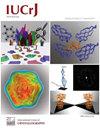多极模型优化的柔性问题。四(μ-醋酸)二水铜模型体系的DFT基准研究。
IF 3.6
2区 材料科学
Q2 CHEMISTRY, MULTIDISCIPLINARY
引用次数: 0
摘要
在本研究中,通过DFT参考计算的四(μ-乙酰)双aquadiccopper模型体系(CCDC参考文献1811668)的结构因子,研究了多极Hansen-Coppens (HC)模型精化的灵活性。从统计误差分析、残差和变形密度图、原子in Molecules参数、d轨道居群等方面考虑了分辨率[sin(θ)/λ]、Cu散射因子、各向异性位移参数和原子在精化过程中的位置的影响。尽管所研究的配合物中铜具有正式的Cu2+性质,但HC细化中中性Cu散射因子的选择对大多数监测参数都给出了最满意的结果。为了使HC模型与参考DFT (BLYP泛函)结果之间的差异在合适的尺度上,将几种计算化学方法(B3LYP, hartrei - fock, Møller-Plesset摄动理论和耦合簇单双)与所选的DFT参考进行了比较。提出了结构因子和AIM参数的大小差异,包括相对论效应和周期边界条件的考虑,即分子晶体计算与晶体中孤立分子的比较。本文章由计算机程序翻译,如有差异,请以英文原文为准。
On the flexibility of the multipole model refinement. A DFT benchmark study of the tetrakis(μ-acetato)diaquadicopper model system
The refinement flexibility of the Hansen–Coppens multipole model is tested on DFT calculated structure factors for the tetrakis(μ-acetato)diaquadicopper model system. The Cu scattering factor performs the best of all the options tried for most of the monitored parameters despite the Cu2+ nature of the complex studied. The Hansen–Coppens model performs similarly well when comparing deviations among computational chemistry methods.
In this study, the flexibility of the multipole Hansen–Coppens (HC) model refinement is investigated on calculated structure factors from a DFT reference for the tetrakis(μ-acetato)diaquadicopper model system (CCDC reference 1811668). The effect of the resolution [sin(θ)/λ], the Cu scattering factor, the inclusion of anisotropic displacement parameters and the positions of the atoms in the refinement are considered in terms of statistical error analysis, residual and deformation density maps, Atoms In Molecules parameters, d-orbital populations, and others. The choice of the neutral Cu scattering factor in the HC refinement is found to give the most satisfactory results for most of the monitored parameters, despite the formal Cu2+ nature of copper in the studied complex. In order to put the difference between the HC model and the reference DFT (BLYP functional) results on the right scale, several computational chemistry methods (B3LYP, Hartree–Fock, Møller–Plesset perturbation theory and Coupled Clusters Singles and Doubles) were compared with the chosen DFT reference. Differences in the magnitudes of the structure factors and AIM parameters are presented, including considerations of relativistic effects and periodic boundary conditions, i.e. a comparison of a molecular crystal calculation versus an isolated molecule in the crystal.
求助全文
通过发布文献求助,成功后即可免费获取论文全文。
去求助
来源期刊

IUCrJ
CHEMISTRY, MULTIDISCIPLINARYCRYSTALLOGRAPH-CRYSTALLOGRAPHY
CiteScore
7.50
自引率
5.10%
发文量
95
审稿时长
10 weeks
期刊介绍:
IUCrJ is a new fully open-access peer-reviewed journal from the International Union of Crystallography (IUCr).
The journal will publish high-profile articles on all aspects of the sciences and technologies supported by the IUCr via its commissions, including emerging fields where structural results underpin the science reported in the article. Our aim is to make IUCrJ the natural home for high-quality structural science results. Chemists, biologists, physicists and material scientists will be actively encouraged to report their structural studies in IUCrJ.
 求助内容:
求助内容: 应助结果提醒方式:
应助结果提醒方式:


